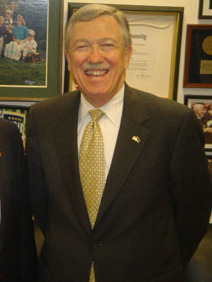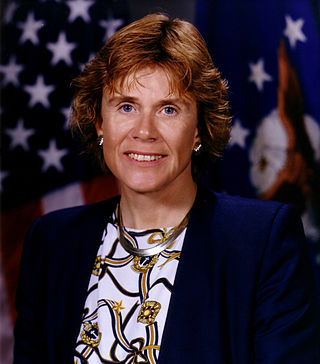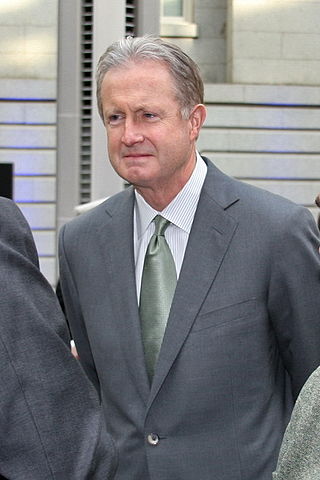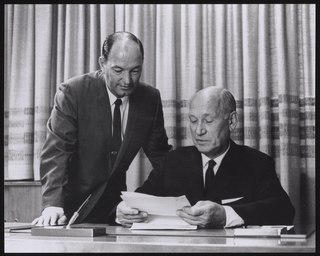Related Research Articles

Guion Stewart Bluford Jr. is an American aerospace engineer, retired United States Air Force (USAF) officer and fighter pilot, and former NASA astronaut, in which capacity he became the first African American to go to space. While assigned to NASA, he remained a USAF officer rising to the rank of colonel. He participated in four Space Shuttle flights between 1983 and 1992. In 1983, as a member of the crew of the Orbiter Challenger on the mission STS-8, he became the first African American in space as well as the second person of African descent in space, after Cuban cosmonaut Arnaldo Tamayo Méndez.
Charles Stark "Doc" Draper was an American scientist and engineer, known as the "father of inertial navigation". He was the founder and director of the Massachusetts Institute of Technology's Instrumentation Laboratory, later renamed the Charles Stark Draper Laboratory, which made the Apollo Moon landings possible through the Apollo Guidance Computer it designed for NASA.

Norman (Norm) Ralph Augustine is a U.S. aerospace businessman who served as United States Under Secretary of the Army from 1975 to 1977. Augustine served as chairman and CEO of the Lockheed Martin Corporation. He was chairman of the Review of United States Human Space Flight Plans Committee.

Simon "Si" Ramo was an American engineer, businessman, and author. He led development of microwave and missile technology and is sometimes known as the father of the intercontinental ballistic missile (ICBM). He also developed General Electric's electron microscope. He played prominent roles in the formation of two Fortune 500 companies, Ramo-Wooldridge and Bunker Ramo Corporation.

Martin Charles Jischke (JIS-key) is a prominent American higher-education administrator and advocate, and was the tenth president of Purdue University.

Edward "Pete" Cleveland Aldridge Jr. is an aerospace engineer and former government official in the U.S. Defense Department. He was also selected as a payload specialist for the Space Shuttle mission STS-62-A, scheduled to launch in July 1986. The mission was canceled after the Space Shuttle Challenger disaster in January 1986, and Aldridge never flew.
The Aerospace Corporation is an American nonprofit corporation that operates a federally funded research and development center (FFRDC) in El Segundo, California. The corporation provides technical guidance and advice on all aspects of space missions to military, civil, and commercial customers. As the FFRDC for national-security space, Aerospace works closely with organizations such as the United States Space Force and the National Reconnaissance Office (NRO) to provide "objective technical analyses and assessments for space programs that serve the national interest". Although the USSF and NRO are the primary customers, Aerospace also performs work for civil agencies such as NASA and NOAA as well as international organizations and governments in the national interest.
Vance D. Coffman was the former chairman of the board and chief executive officer of Lockheed Martin Corporation. He has additionally served on the board of directors for 3M, John Deere, and Amgen.

Eberhardt Rechtin was an American systems engineer and respected authority in aerospace systems and systems architecture.

Sheila Marie Evans Widnall is an American aerospace researcher and Institute Professor Emerita at the Massachusetts Institute of Technology (MIT). She served as United States Secretary of the Air Force from 1993 to 1997, making her the first woman to hold that post and the first woman to lead an entire branch of the United States Armed Forces in the Department of Defense. She was inducted into the National Women's Hall of Fame in 2003.

James F. Albaugh is the former executive vice president of The Boeing Company and chief executive officer of the Boeing Commercial Airplanes business unit. He served in these capacities for Boeing Commercial Airplanes from September 1, 2009, until his retirement on June 26, 2012. He retired from the company on October 1, 2012. He previously served as president and chief executive officer of the Boeing Defense, Space & Security business unit. In that capacity, Albaugh was responsible for over 70,000 employees and supervised a $30.8 billion budget. Albaugh was one of the defense industry's best-paid managers.
Henry Thomas Sampson Jr. was an American engineer, inventor and film historian who created the gamma-electric cell in 1972 — a device with the main goal of generating auxiliary power from the shielding of a nuclear reactor.

Edson Fessenden Gallaudet was a pioneer in the field of aviation. He was best known for his development of practical airfoils and aircraft propulsion systems for use in early seaplanes.

Joseph Vincent Charyk was widely credited as the founder of the geosynchronous communications satellite industry. He was born in Canmore, Alberta to a Ukrainian family. Early in his career, Charyk consolidated the Central Intelligence Agency, United States Air Force, and United States Navy space programs into the National Reconnaissance Office (NRO). He brought the first United States imagery satellite, CORONA, into operation and demonstrated signals intelligence technology from space. During his tenure, the NRO operated the U-2 reconnaissance aircraft and managed development of the A-12.
A Sivathanu Pillai is an Indian scientist who formerly served as Honorary Distinguished Professor at Indian Space Research Organisation (2015-2018) and an honorary professor at IIT Delhi in the Department of Mechanical Engineering (2015-2016) and a Visiting Professor at Indian Institute of Science (2014-2015).

H. Norman Abramson is an American engineer, scientist, retired Executive Vice President of the Southwest Research Institute at the University of Texas at Austin, and former manager and principal investigator in several NAE and NRC research projects.

William F. Ballhaus Sr. was an engineer who worked in the field of aircraft and manufacturing. He was educated at Stanford University and California Institute of Technology. He was employed at various posts in aircraft design and manufacture at Douglas, Convair, and Northrop. In 1965, he was appointed president of Beckman Instruments, where he gradually converted the manufacturing focus from defense to medical instruments. Ballhaus had a keen interest in economics, particularly in the relationship between tax policy and growth, and played a role in the lowering of capital gains taxes by Congress in 1978. He was elected to the National Academy of Engineering in 1973 and, with the election of his son, William F. Ballhaus Jr., to the same institution, they became the first father-son members of NAE.
William L. Ballhaus is an American businessman, entrepreneur, and third-generation aerospace engineer. Since 2016, he has served as the Chairman, President and CEO of Blackboard Inc. He served as the Chief Executive Officer and President of DynCorp, a global government services provider, from 2008 to 2010. He served as the Chief Executive Officer and President of SRA International from 2011 to 2015, at which time he led the merger of SRA with CSC's federal business to create CSRA.

Kenneth Stanley Reightler Jr. is a former NASA astronaut.
References
- ↑ "William F. Ballhaus Jr. Elected CEO".
- ↑ "Dr. William F. Ballhaus Jr., Named President of the Aerospace Corporation". 11 July 2000.
- ↑ http://www.nationalspacesymposium.org/speakers/ballhaus-jr-dr-william-f [ dead link ]
- ↑ http://goliath.ecnext.com/coms2/gi_0199-5674651/William-F-Ballhaus-Jr.html [ dead link ]
- ↑ "50 Years in Space - William F. Ballhaus, Jr". galcit.caltech.edu. Retrieved 2021-04-07.
- ↑ Obituary (2014) AIAA Fellow Ballhaus Died in August 2013, Aerospace America 52(1), B21.